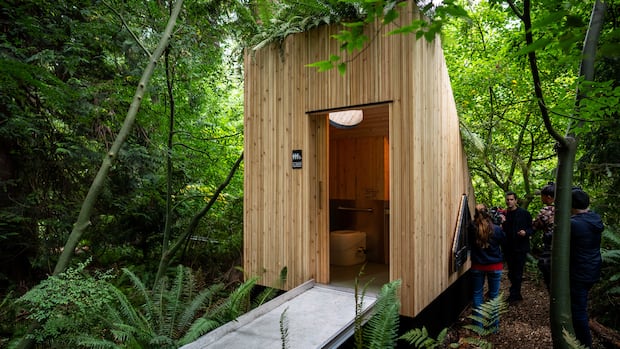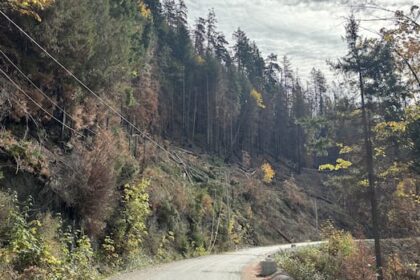British ColumbiaDubbed the MycoToilet, researchers say the system separates liquids and solids, using a mycelium-lined chamber to absorb 90 per cent of odour-causing compounds.Researchers testing prototype, which they say eliminates odours associated with composting toiletsNono Shen · The Canadian Press · Posted: Oct 13, 2025 8:00 AM EDT | Last Updated: 3 hours agoA mushroom-powered waterless toilet, shown in this photo, was launched by researchers at the University of British Columbia at UBC Botanical Garden in September 2025. (Ben Nelms/CBC)A “beautiful experience” isn’t a term often used for a trip to an outhouse, but researchers at the University of British Columbia say the description fits for their mushroom-powered waterless toilet.The toilet turns human waste into compost using mycelia, the root network of mushrooms. The MycoToilet, inside the small cedar-sided building, has been dropped in among the trees at the university’s Botanical Garden for a six-week test run. The toilet separates liquids from solids, with the solid waste going into a mycelium-lined compartment, where lab tests have shown 90 per cent of the odour-causing compounds are absorbed. Steven Hallam, a professor in the department of microbiology and immunology at the university, said they’ve known for a long time that tree roots have certain fungi that help trees absorb nutrients and protect them from pathogens.Joseph Dahmen, the project’s lead and an associate professor at UBC’s School of Architecture, says composting toilets often stand out in people’s minds because of the smell associated with them and his team wanted to design one that’s both sustainable and odour-free. (Ben Nelms/CBC)”We have learned that the breathable mycelium liner can reduce odour, while removing residual moisture, limiting the onset of anaerobic conditions and creating more favourable conditions for aerobic decomposition,” said Hallam.The modular toilet requires just four maintenance visits a year. Once operational, it’s expected to produce around 600 litres of soil and 2,000 litres of liquid fertilizer a year. Joseph Dahmen, the project’s lead and an associate professor at UBC’s school of architecture, said composting toilets “stand out in people’s minds because of the smell associated with them.”He said they explored materials for their toilet that could not only create a sustainable way to “green the campus” but reduce the odour. “We really wanted to use the design to recontextualize an activity that we often take for granted and do without thinking, to kind of put it in a new light and suggest that a waste-separating toilet doesn’t have to be a kind of sacrifice to use,” said Dahmen.”But it can be a really beautiful experience that connects us to natural ecologies.”Dahmen said one user even compared the toilet to a Scandinavian sauna experience. Prefabricated timber panels form the structure, there’s a skylight above and the green roof supports local plants. A low-power fan keeps air circulating and a ramp leads to the entrance. UBC researchers say the modular toilet requires just four maintenance visits a year and is wheelchair-accessible. (Ben Nelms/CBC)Hallam said the installation is a “living laboratory” as researchers will be evaluating the performance of the liner over time to understand how the use of different mushrooms might affect circulation. He said they’ll be evaluating the performance of the mushroom liner over the six weeks it’s at the garden, using a combination of analytical and DNA bar coding methods to better understand certain issues, including pathogen loading.”So, everyone who’s using that toilet is also engaged in citizen science effectively,” said Hallam.”Our hope is that the entire liner can be converted to usable compost, supporting local plant life in the botanical garden and beyond.” Dahmen said that during his classes, he would ask students about what happens to their waste after flushing, most didn’t know the answer. The toilet uses mycelium, the root system of mushrooms, to break down human waste into compost (Ben Nelms/CBC)Although the current wastewater treatment infrastructure plays an important role in our society, it ultimately results in liquid effluents being released into rivers and streams after treatment, said Dahmen. “It’s probably time to rethink some of those with new conceptual frameworks, so that we approach it not as waste, but as a source of nutrients that are valuable and can contribute to local ecosystems,” said Dahmen. Hallam agreed that large-scale wastewater plants won’t go away any time soon, but there is a movement within the wastewater treatment community to rethink the concept as a waste resource recovery system.Steven Hallam and Joseph Dahmen are pictured with the mushroom-powered waterless toilet. Dahmen said one user even compared the toilet to a Scandinavian sauna experience. (Ben Nelms/CBC)”Waste is a function of our values, and if we can rethink what we value in this context, there’s lots of useful material in these effluents, and we can recover that, then we’re adding value back and creating a more circular model for the economy and our lives,” said Hallam. The World Health Organization released a report this summer on drinking water and sanitation, showing 3.4 billion people still lack safely managed sanitation”Despite progress over the last decade, billions of people around the world still lack access to essential water, sanitation, and hygiene services, putting them at risk of disease and deeper social exclusion,” WHO says in a statement. Dahmen said they are also hoping to see these kinds of toilets used in lower-income countries to meet their sanitation needs.
University of B.C. launches mushroom-powered toilet, turning waste into fertilizer












